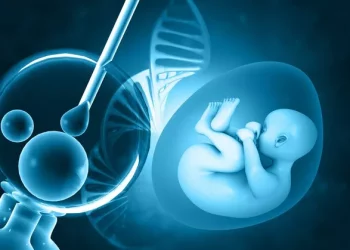Hypospermia, defined as reduced semen volume, is a condition of significance in the realm of male fertility. Semen volume is a crucial parameter in assessing male reproductive health, as it directly impacts the chances of fertilization during intercourse. Understanding the causes of hypospermia is essential for diagnosing and managing fertility issues effectively.
Causes of Hypospermia
1. Hormonal Factors
Hormonal imbalances play a significant role in contributing to hypospermia. Reduced levels of testosterone, the primary male sex hormone, can negatively affect sperm production and semen volume. Additionally, abnormalities in the function of the pituitary gland, which regulates hormone production, may also lead to decreased semen volume.
2. Medical Conditions
Several medical conditions can contribute to hypospermia:
Varicocele
Varicocele is a condition characterized by the enlargement of veins within the scrotum. This enlargement can disrupt the normal temperature regulation of the testes, leading to impaired sperm production and reduced semen volume. Varicoceles are a common cause of male infertility and may require surgical intervention for correction.
Infections
Infections of the reproductive system, such as prostatitis (inflammation of the prostate gland) or epididymitis (inflammation of the epididymis), can result in hypospermia. These infections may impair sperm production or disrupt the normal flow of semen, leading to decreased ejaculate volume.
Retrograde Ejaculation
Retrograde ejaculation occurs when semen travels backward into the bladder instead of being expelled through the urethra during ejaculation. This can occur due to dysfunction of the bladder neck muscles or the prostate gland, resulting in reduced ejaculate volume and potential fertility issues.
Ejaculatory Duct Obstruction
Blockages in the ejaculatory ducts, which are responsible for transporting semen from the seminal vesicles to the urethra during ejaculation, can prevent semen from being released properly. This obstruction can lead to decreased semen volume and may require surgical intervention to correct.
3. Lifestyle Factors
Certain lifestyle choices and habits can also impact semen volume:
Smoking
Smoking has been linked to decreased sperm count, motility, and semen volume. The harmful chemicals present in tobacco smoke can disrupt the delicate balance of hormones involved in sperm production, leading to fertility issues and hypospermia.
Alcohol and Drug Use
Excessive alcohol consumption and drug use, including recreational drugs and anabolic steroids, can adversely affect male fertility. These substances can disrupt hormonal balance, impair sperm production, and contribute to hypospermia.
Stress
Chronic stress can have a detrimental effect on reproductive health by disrupting hormone levels and reducing sperm quality. High levels of stress hormones, such as cortisol, can interfere with the production and maturation of sperm, leading to decreased semen volume and fertility problems.
4. Medications
Certain medications may cause hypospermia as a side effect:
Antidepressants
Some antidepressant medications, particularly selective serotonin reuptake inhibitors (SSRIs), have been associated with decreased semen volume. These drugs may interfere with the normal function of the reproductive system, leading to fertility issues in some individuals.
Antihypertensive Drugs
Certain antihypertensive medications, such as alpha-blockers and calcium channel blockers, can impact ejaculation and semen volume. These drugs may affect the nerves and muscles involved in ejaculation, leading to decreased ejaculate volume in some cases.
Diagnostic Evaluation
Diagnosing hypospermia typically involves a comprehensive evaluation, including:
1. Medical History
A thorough review of the patient’s medical history, including any underlying medical conditions, medications, or lifestyle factors that may contribute to hypospermia.
2. Physical Examination
A physical examination may be performed to assess the health of the reproductive organs and identify any abnormalities that could be contributing to hypospermia.
3. Semen Analysis
A semen analysis is a critical diagnostic tool for evaluating male fertility. This test assesses various parameters of semen quality, including volume, sperm count, motility, and morphology. A low semen volume is indicative of hypospermia and may warrant further investigation into its underlying causes.
Treatment Options
Treatment for hypospermia depends on the underlying cause and may include:
1. Hormone Replacement Therapy
Hormone therapy may be recommended to correct hormonal imbalances that contribute to hypospermia. This approach aims to restore normal hormone levels and improve sperm production and semen volume.
2. Surgical Intervention
Surgical procedures may be necessary to address anatomical issues contributing to hypospermia, such as varicocele repair or removal of ejaculatory duct blockages. These interventions aim to restore normal reproductive function and improve semen volume.
3. Lifestyle Modifications
Adopting a healthy lifestyle can positively impact semen volume and overall reproductive health. This includes regular exercise, a balanced diet rich in essential nutrients, and avoiding harmful substances such as tobacco, alcohol, and recreational drugs.
4. Fertility Treatments
Assisted reproductive techniques, such as intrauterine insemination (IUI) or in vitro fertilization (IVF), may be recommended for couples experiencing fertility challenges due to hypospermia. These techniques can help overcome barriers to conception and achieve successful pregnancy.
Prevention and Prognosis
Preventing hypospermia involves:
1. Maintaining a Healthy Lifestyle
Engaging in regular exercise, following a balanced diet, and avoiding exposure to toxins can help preserve reproductive health and prevent hypospermia.
2. Prompt Medical Attention
Seeking prompt medical attention for any reproductive health concerns can help diagnose and manage hypospermia effectively, improving the prognosis for individuals affected by this condition.
Conclusion
In conclusion, hypospermia is a condition characterized by reduced semen volume that can have significant implications for male fertility. Understanding the causes, diagnostic evaluation, and treatment options for hypospermia is essential for optimizing reproductive health and addressing fertility issues. Individuals experiencing concerns about semen volume or fertility should consult a healthcare professional for personalized guidance and management.
Related Topics:
An Overview of How Common Is Male Infertility?



























